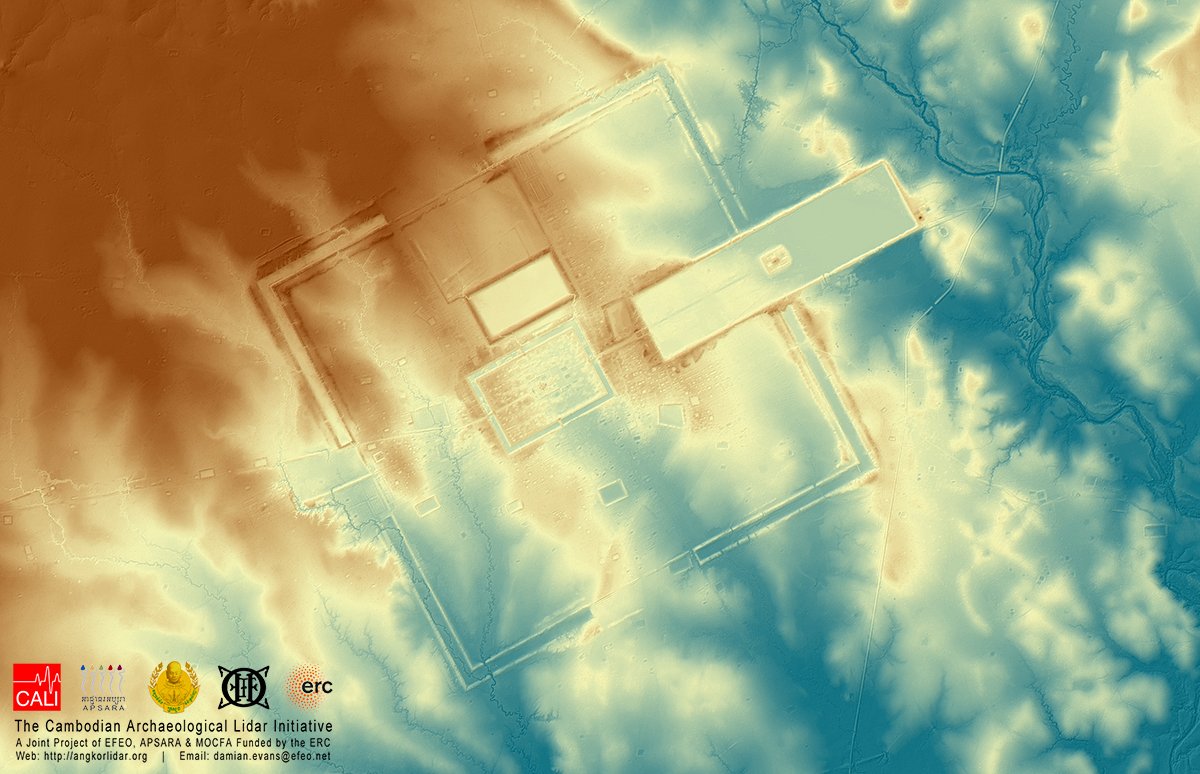"Water systems were also discovered, which shows the technology was used hundreds of years earlier than previously believed."
" ... the Khmer empire could have been the largest in the world at its time."
Image is from the Cambodian Archaeological Lidar Initiative (CALI) website. The following RT report is a summary based on The Guardian's exclusive interview with archaeologists who are working on CALI; the Guardian report was published June 10 and features graphics and photographs connected with the 'earthshaking' research.
I note that the research on Angkor Wat's sophisticated water management system is not new. Archaeologist Damian Evans, who's involved with CALI, has published at least as early as 2008 on the system -- although it's possible that more about the system was revealed by the laser technology; I haven't read any of the studies so this is all new to me.
RT
June 14, 2016
Laser technologies have uncovered a vast network of hidden cities surrounding Cambodia’s famous Angkor Wat temples that reveals the Khmer empire could have been the largest in the world at its time.
Australian archaeologist Damian Evans’ findings, which are due to be published in the Journal of Archaeological Science on Monday, detail the scale of the discovery surrounding the temples of Angkor Wat, the largest religious monument in the world.
Cutting-edge laser technology, known as Lidar, which is fired from a helicopter into the ground, penetrating through forests, was used to produce detailed imagery of the Earth’s surface. It revealed a network of ancient cities between 900 and 1,400 years old, with some as big as Cambodia’s capital Phnom Penh, according to The Guardian.
The data, captured in 2015, suggests the Khmer empire would have been the largest in the world during the 12 century.
Evans first carried out a light detection and ranging study in 2012, and the project received funding from the European Research Council as a result.
The 2012 study revealed connections between Angkor Wat and other temple cities like Koh Ker. It also confirmed the presence of Mahendraparvata, a city beneath Mount Kulen, and the more recent survey revealed the scale of that city.
Water systems were also discovered, which shows the technology was used hundreds of years earlier than previously believed.
David Chandler, emeritus professor at Monash University in Melbourne and one of the leading experts on Cambodian history, described the findings as “game-changing,” saying it had succeeded in “putting hundreds of nameless, ordinary, Khmer-speaking people back into Cambodia’s past.”
The new discovery also debunks a previously held theory that suggested the Khmer had fled from the area when the Thais invaded in the 15th Century. “That didn’t happen, there are no cities [revealed by the aerial survey] that they fled to. It calls into question the whole notion of an Angkorian collapse,” Evans said.
[...]
Images from new laser technology being used to find lost ancient cities
Image is from the Cambodian Archaeological Lidar Initiative (CALI) website. The following RT report is a summary based on The Guardian's exclusive interview with archaeologists who are working on CALI; the Guardian report was published June 10 and features graphics and photographs connected with the 'earthshaking' research.
I note that the research on Angkor Wat's sophisticated water management system is not new. Archaeologist Damian Evans, who's involved with CALI, has published at least as early as 2008 on the system -- although it's possible that more about the system was revealed by the laser technology; I haven't read any of the studies so this is all new to me.
RT
June 14, 2016
Laser technologies have uncovered a vast network of hidden cities surrounding Cambodia’s famous Angkor Wat temples that reveals the Khmer empire could have been the largest in the world at its time.
Australian archaeologist Damian Evans’ findings, which are due to be published in the Journal of Archaeological Science on Monday, detail the scale of the discovery surrounding the temples of Angkor Wat, the largest religious monument in the world.
Cutting-edge laser technology, known as Lidar, which is fired from a helicopter into the ground, penetrating through forests, was used to produce detailed imagery of the Earth’s surface. It revealed a network of ancient cities between 900 and 1,400 years old, with some as big as Cambodia’s capital Phnom Penh, according to The Guardian.
The data, captured in 2015, suggests the Khmer empire would have been the largest in the world during the 12 century.
Evans first carried out a light detection and ranging study in 2012, and the project received funding from the European Research Council as a result.
The 2012 study revealed connections between Angkor Wat and other temple cities like Koh Ker. It also confirmed the presence of Mahendraparvata, a city beneath Mount Kulen, and the more recent survey revealed the scale of that city.
Water systems were also discovered, which shows the technology was used hundreds of years earlier than previously believed.
David Chandler, emeritus professor at Monash University in Melbourne and one of the leading experts on Cambodian history, described the findings as “game-changing,” saying it had succeeded in “putting hundreds of nameless, ordinary, Khmer-speaking people back into Cambodia’s past.”
The new discovery also debunks a previously held theory that suggested the Khmer had fled from the area when the Thais invaded in the 15th Century. “That didn’t happen, there are no cities [revealed by the aerial survey] that they fled to. It calls into question the whole notion of an Angkorian collapse,” Evans said.
[...]
********

No comments:
Post a Comment